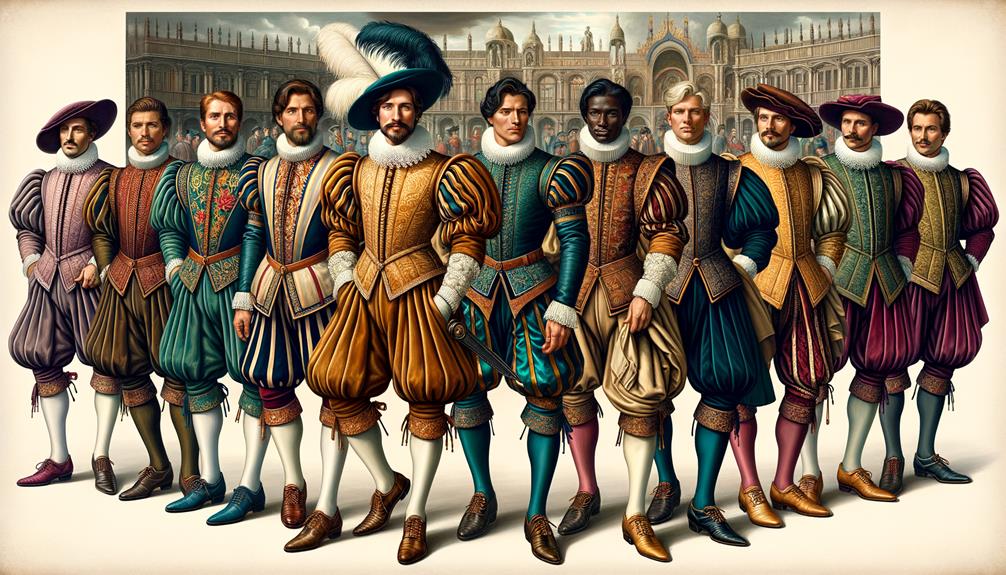Renaissance embroidery, born in 14th century Italy, spread across Europe by the 15th and 16th centuries, symbolizing power and prestige. Skilled artisans mastered techniques like raised embroidery and stumpwork, transforming linen and velvet into vibrant art with natural dyes. Regional styles emerged, with Italian goldwork, German geometric boldness, French floral delicacy, and English hybrids. Embroidered clothing and accessories told stories of dominion and devotion. Even household items, from table linens to wall tapestries, became canvases for intricate motifs. Today, contemporary fashion still draws inspiration from these ancient techniques, preserving their legacy through exhibitions and online tutorials. There's more to these stitches than meets the eye.
Historical Context
Renaissance embroidery, which emerged in 14th century Italy, flourished across Europe during the 15th and 16th centuries. This art form marked a departure from the simpler designs of the Middle Ages, as it combined opulence with meticulous craftsmanship. Nobility and royalty were captivated by its intricate designs, and they patronized the artisans who skillfully wielded needles.
In grand halls and courts, embroidery was more than just decoration. It symbolized power and prestige. Each stitch confirmed wealth, adorning garments, tapestries, and ecclesiastical vestments, transforming them into visual masterpieces of silk and metallic threads. Floral patterns, religious icons, and mythological figures danced across the fabric, telling tales of divinity and grandeur.
As the Middle Ages gave way to the Renaissance, embroidery evolved from functional to ornamental. The designs became more intricate, and the themes more diverse. Geometric patterns and heraldic emblems reflected a society undergoing transformation, embracing both the past and the innovative spirit of the time.
Renaissance embroidery was not just art; it was a cultural statement. It reflected a world where tradition merged with innovation, and every stitch told a story of a civilization on the cusp of modernity.
Techniques and Materials
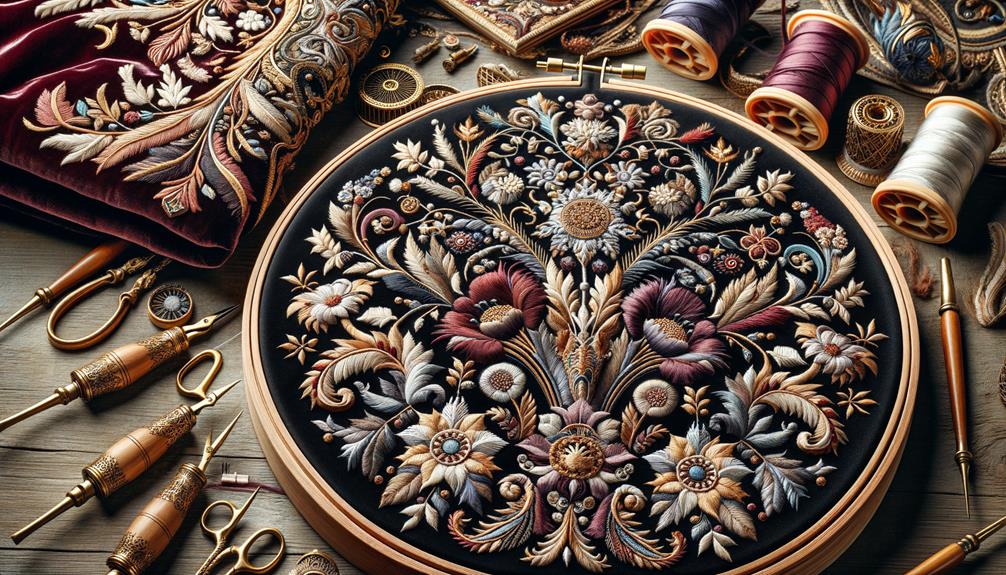
Artisans of the Renaissance wielded their needles with precision, crafting intricate designs through techniques like raised embroidery, stumpwork, and blackwork. These methods required unparalleled skill, transforming silk threads and gold filigree into art. The tactile elegance of couching and needle painting added depth, while linen and velvet fabrics provided a rich canvas.
Natural dyes gave birth to vibrant hues, each stitch a tribute to the artisan's mastery. Themes ranged from delicate florals to solemn religious motifs, echoing the era's reverence for both nature and the divine. Embroidery wasn't mere decoration; it was a narrative woven into the fabric of society.
Today, machine embroidery pays homage to this legacy, merging tradition with innovative precision. The meticulous craftsmanship of the Renaissance continues to inspire, a symbol of luxury in contemporary fashion and ceremonial garments. Precious gemstones and pearls, once sewn by hand, are now seamlessly integrated by machinery, yet the essence remains unchanged.
The evolution from hand to machine doesn't diminish the art form; it expands its reach and application. Renaissance techniques endure, their influence indelible, a bridge between past opulence and modern ingenuity.
Regional Styles
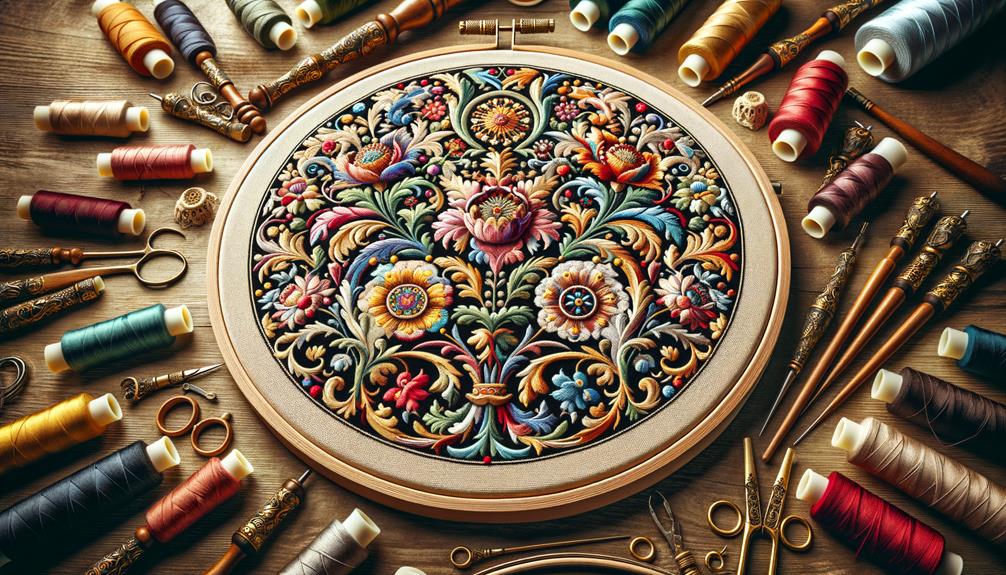
Each region's embroidery during the Renaissance had its own distinct character, reflecting local artistic traditions and cultural influences. Italian embroidery was renowned for its intricate goldwork and silk shading, evoking a luxurious style reminiscent of royal courts. The precision and mastery in these stitches reflected a culture that highly valued both art and craftsmanship.
In contrast, German embroidery featured bold colors and complex geometric patterns, creating a striking visual effect. This regional style showcased an innovative spirit, pushing boundaries with its vibrant hues and structured forms.
French embroidery, on the other hand, was characterized by delicate floral motifs and fine stitch work, exuding elegance. Each petal and leaf reflected the exquisite attention to detail that defined French artistry. These pieces often conveyed subtle sophistication, underscoring the refinement of their creators.
English embroidery blended influences from across Europe, resulting in a unique hybrid style. This eclectic approach led to works that incorporated elements from multiple traditions, yet maintained a cohesive beauty. The blend of different techniques and motifs reflected a rich cultural exchange and artistic evolution.
Iconic Motifs
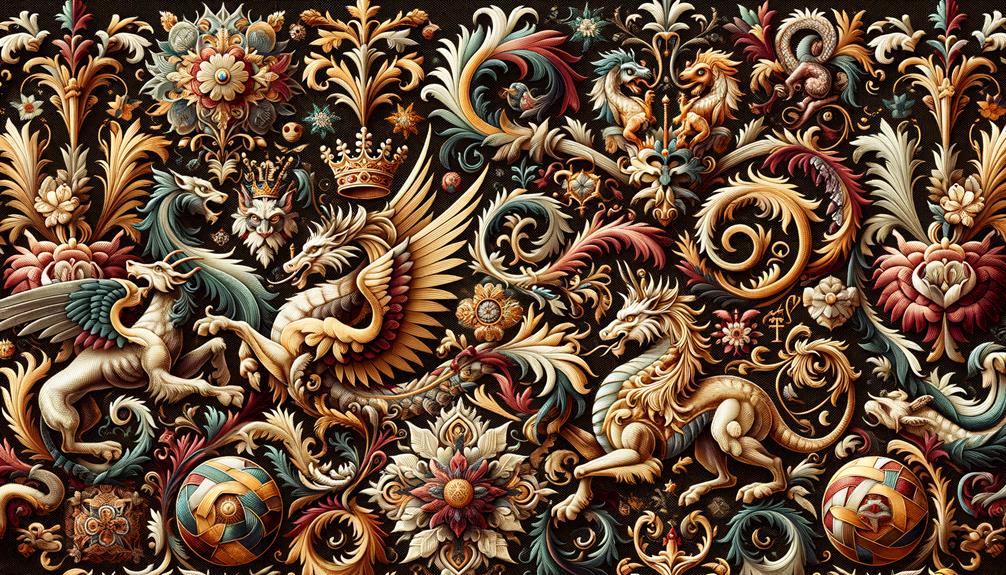
As we delve into the diverse regional styles, our attention shifts to the iconic motifs that adorned Renaissance embroidery, each stitch telling tales of nature, faith, myth, lineage, and geometry. Floral designs, reminiscent of the natural world's delicate beauty, bloomed with roses, lilies, and vines, weaving intricate tapestries that celebrated life's fleeting grace.
Religious symbols and biblical scenes held significant influence, reflecting an era deeply rooted in faith. Crosses, angels, and sacred hearts bore witness to the divine, grounding fabric in spirituality. Mythological figures, drawn from Greek and Roman lore, added layers of classical elegance. Gods and heroes, frozen in thread, brought ancient stories to life, enriching garments with timeless narratives.
Heraldic emblems, stitched with precision, showcased noble lineage and status. Coats of arms, crests, and family symbols spoke of heritage and honor, silently declaring identity. Geometric designs, influenced by Islamic art, offered a dance of symmetry and pattern. Intricate lines and shapes, executed with mathematical precision, revealed a fascination with order and beauty.
In these embroidery patterns, the Renaissance found its voice. Each motif, a fragment of a grander story, rendered in needle and thread, spoke of an age where art and life intertwined seamlessly.
Clothing and Accessories
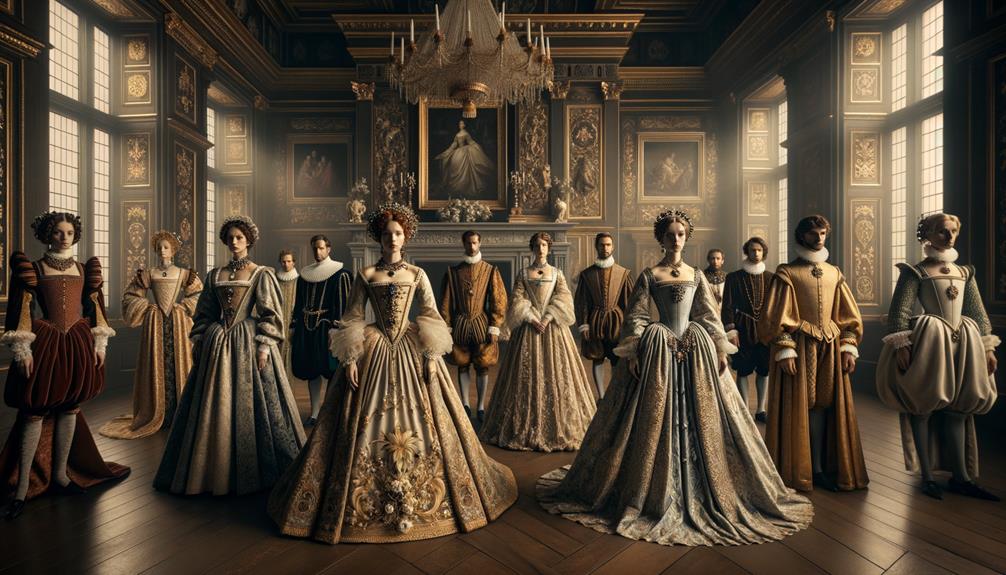
I see Renaissance embroidery transforming clothing into wearable art. Dresses and accessories shimmer with silk and gold threads, each piece a testament to refinement and sophistication. Delicate floral patterns and mythological figures adorn the fabric, reflecting a world where opulence and craftsmanship converge.
Embroidered Fashion Trends
During the Renaissance, exquisite embroidery told stories of power and piety on luxurious fabrics. Noble families showcased their wealth and status through intricate designs, flaunting their societal position. Floral patterns, religious symbols, and geometric motifs adorned their clothing, each stitch a testament to their prestige.
Hoop embroidery played a crucial role, allowing for precision in creating these detailed works. Techniques like raised embroidery, stumpwork, and blackwork transformed simple fabrics into masterpieces. The Renaissance period saw an explosion of creative expression in fashion, driven by:
Materials like silk threads, gold and silver embellishments, and luxurious fabrics like velvet.
Techniques such as raised embroidery, stumpwork, and blackwork.
Designs featuring intricate floral patterns, religious symbols, and geometric motifs.
These elements combined to create garments that were more than just clothing – they were statements of identity and influence. The impact of Renaissance embroidery endures, influencing contemporary fashion and preserved in museum collections worldwide. Each piece tells a story of innovation, artistry, and the relentless pursuit of beauty. Today, the echoes of those golden threads continue to inspire modern design, a testament to their lasting legacy.
Ornate Accessory Designs
In the Renaissance, accessories were elevated to an art form with intricate embroidery, transforming ordinary items into opulent expressions of craftsmanship. Each piece showcased meticulous attention to detail, as embroidery designs brought life to even the most mundane accessories.
Embroidered motifs adorned gloves, belts, caps, and handbags, offering a glimpse into the wearer's social status and personal taste. The designs ranged from majestic lions to enigmatic portraits, each stitch telling a silent story. Embroidered appliques and patches in Renaissance font became hallmarks of elegance.
| Accessory | Embroidery Design | Price Range (USD) |
|---|---|---|
| Gloves | Renaissance motifs | $136.27 – $467.10 |
| Belts | Lions, floral patterns | $136.27 – $467.10 |
| Caps | Intricate lacework | $136.27 – $467.10 |
| Handbags | Mona Lisa, initials | $136.27 – $467.10 |
Handmade and custom Renaissance pieces embodied a time when fashion was an art form. Digital downloads now allow enthusiasts to recreate these embroidery designs, merging past elegance with modern creativity. The delicate lacework and bold patterns remain timeless, bridging eras through a shared appreciation of beauty.
Each embroidered accessory, then and now, carries forward a legacy of innovation and craftsmanship, blending history with contemporary flair.
Household Items
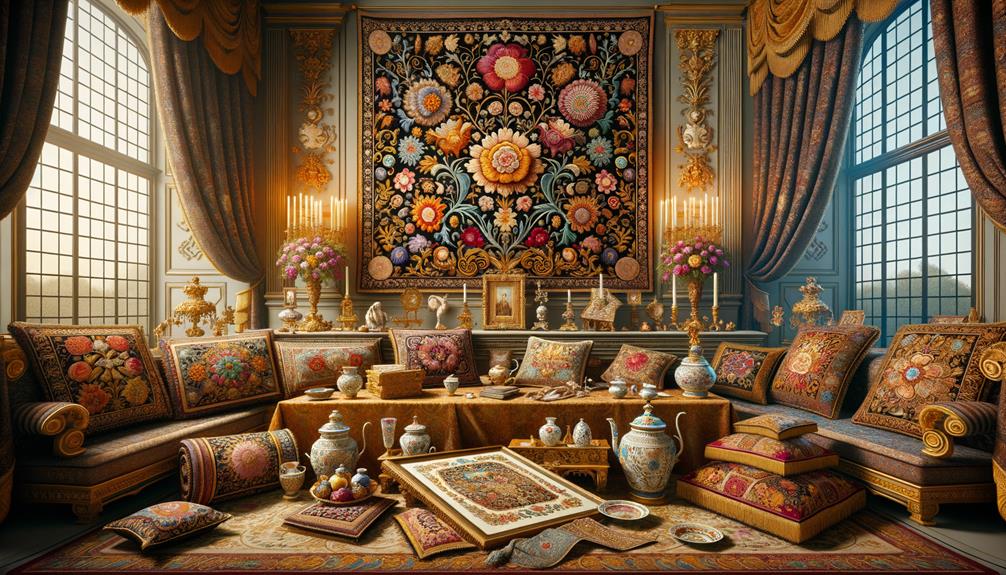
Renaissance embroidery transformed everyday household items into stunning works of art, showcasing exceptional craftsmanship and luxurious materials. This art form elevated ordinary objects into symbols of elegance and sophistication. The intricate threads of silk and gold told stories of opulence and artistry, each stitch a testament to the owner's status and wealth.
Consider these beautifully embroidered household items:
- Table Linens: Floral motifs and geometric patterns adorned these linens, turning meals into regal experiences.
- Curtains: Featuring mythological figures, they added a touch of fantasy and grandeur to interior spaces.
- Cushion Covers: Decorated with intricate designs, they provided both comfort and aesthetic pleasure.
During the Renaissance, embroidery was more than just decoration. It was an innovative art form that transformed bed hangings, wall tapestries, and decorative pillowcases into masterpieces. Each piece reflected the meticulous labor and creative vision of artisans. The floral motifs, geometric patterns, and mythological figures were not just designs but symbols of an era that revered beauty and detail.
In the quiet elegance of these embroidered items, we find a blend of art and utility, a legacy of an age that dared to infuse everyday life with extraordinary beauty.
Contemporary Influence
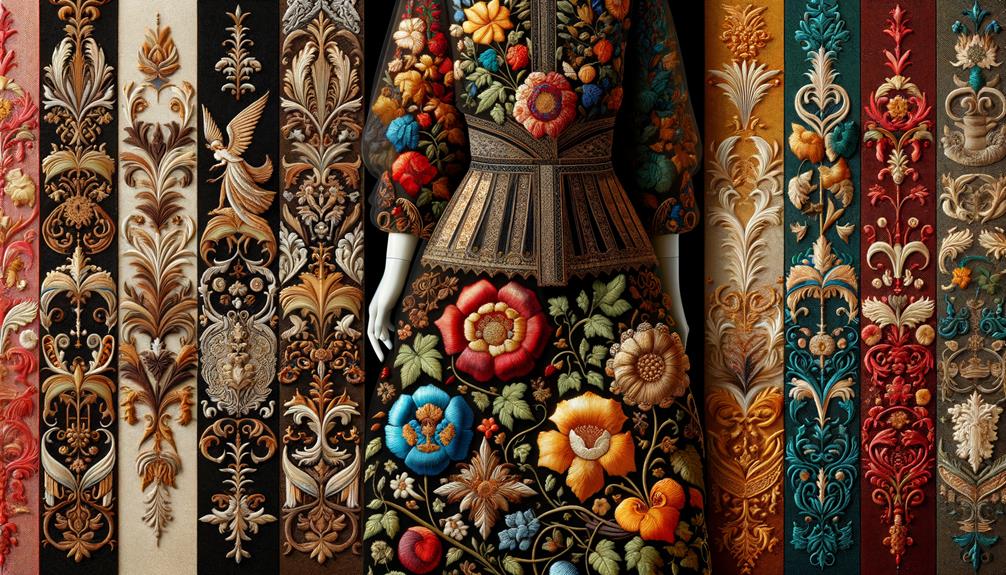
Today, Renaissance embroidery's intricate artistry influences contemporary fashion and design. Designers blend traditional techniques and motifs with modern sensibilities, creating a unique fusion that honors the past while embracing the present.
Modern crafters incorporate Renaissance styles into their projects, crafting pieces that echo centuries-old artistry. Museums and galleries showcase these works, bridging the gap between eras. Online tutorials and workshops also thrive, guiding enthusiasts to recreate the magic of Renaissance embroidery in a modern context.
| Inspiration Source | Modern Application | Resulting Aesthetic |
|---|---|---|
| Renaissance Techniques | Contemporary Fashion | Timeless Elegance |
| Historical Motifs | Modern Craft Projects | Artistic Fusion |
| Museum Exhibits | Current Art Displays | Cultural Continuity |
| Online Tutorials | DIY Embroidery | Skill Revival |
| Stitch Length Filters | Design Precision | Harmonious Blend |
This blend of old and new creates a distinctive, timeless aesthetic. Fashion enthusiasts worldwide celebrate this fusion, where tradition meets innovation. The delicate stitching, informed by historical mastery, finds its place in the modern world, resonating deeply with those seeking a connection to the past through contemporary creativity.
Preservation and Study
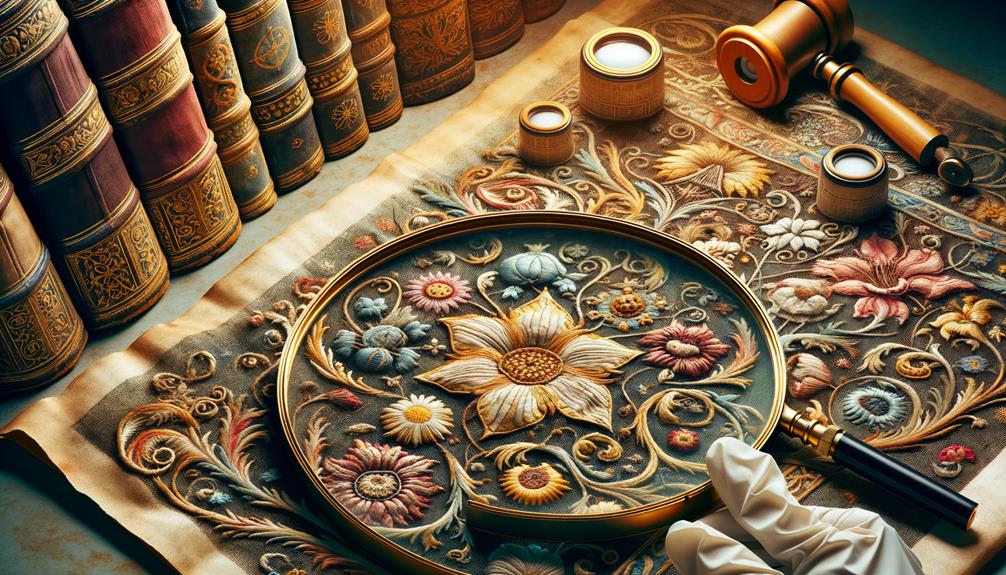
I delve into historical techniques to understand the artisans' skills. Preserving delicate threads and intricate patterns poses significant challenges. Today, advanced methods help protect and study these timeless pieces.
Historical Techniques Analysis
Artifacts of Renaissance embroidery whisper secrets of the past through intricate designs and ancient threads. To decipher these whispers, historians meticulously examine historical techniques, where each embroidery pattern tells a story of skill and creativity. Delicate stitches, carefully chosen motifs, and unique designs reveal a mastery that transcends time.
In preserving and studying these artifacts, researchers at museums and universities engage in a precise and methodical analysis. They start by identifying the types of threads and fabrics used, then dissect the specific stitches and techniques employed. They also catalog the designs and motifs characteristic of the era.
This rigorous approach not only helps in understanding the past but also inspires contemporary innovation in textile arts. Each pattern is a fragment of history, a testament to the artisans' craftsmanship. By studying these elements, we gain insight into the cultural and artistic context of the Renaissance period.
The collaboration between scholars and conservators ensures that the integrity of these pieces is maintained. Through this marriage of art and science, we continue to unravel the mysteries embedded in every thread, stitch, and pattern of Renaissance embroidery.
Conservation Challenges Encountered
Conserving Renaissance embroidery requires meticulous care to protect its delicate beauty from the ravages of time. The fragile threads and fine fabrics of these historical artifacts are vulnerable to decay and handling damage. Each artifact serves as evidence of the past, requiring a controlled environment to slow down the inevitable aging process.
In the quiet of conservation labs, experts meticulously examine every detail, aware that improper storage and previous restorations may have left scars. Their techniques, honed through years of study, blend art and science to preserve the intricate designs. The threat of insect damage and mold growth looms, making vigilance essential.
Renaissance Faire exhibits present another layer of challenge. Transporting and displaying these treasures without compromising their integrity demands innovative solutions. Collaboration is key – conservators, curators, historians, and scientists work together, pooling their expertise to safeguard these delicate masterpieces.
Studying Renaissance embroidery is a journey through time, deciphering the craftsmanship of another era. The effort is exacting, requiring a deep understanding of historical textiles and embroidery techniques. Each piece holds secrets waiting to be uncovered, a silent witness to centuries past. The space between preservation and decay is a delicate balance, a precise dance of care.
Modern Preservation Methods
Modern preservation methods blend science and art to safeguard the delicate threads of Renaissance embroidery for future generations. Each embroidered piece holds a piece of history, yet time threatens to erase its whispers. I employ methods that balance tradition and technology, marrying the old with the new.
To protect these treasures, I use:
- Climate control: Regulating temperature, humidity, and light exposure prevents deterioration.
- High-resolution digital archiving: Capturing every thread in high resolution creates a digital archive.
- Specialized storage: Acid-free materials cradle these artifacts, shielding them from acidic decay.
These preservation methods offer resilience against time's relentless march. In the quiet of the preservation lab, digital scans reveal secrets hidden in the weave. Climate-controlled environments stand guard against decay and pests, while acid-free materials provide a haven untouched by time.
Studying these textiles isn't just about preservation; it's an intimate dialogue with the past. Analyzing materials and techniques reveals the artisans' hands behind each stitch. Through these preservation methods, I safeguard the beauty and history of Renaissance embroidery, ensuring they're not just preserved but understood and cherished.
Frequently Asked Questions
What Is Renaissance Embroidery?
Renaissance embroidery is an intricate art form that originated in Italy, symbolizing wealth and status through luxurious materials and detailed designs. This art form speaks volumes about the era's opulence and refinement, conveying a sense of grandeur that transcends words.
What Is the Cultural Importance of Embroidery?
Embroidery is a timeless art form that weaves together culture, identity, and human expression. Each stitch is a testament to the significance of this craft, which has endured across eras. It's a canvas that intertwines the past and present, making it a vital part of our shared heritage.
Is Embroidery the Craft of Decorating?
Embroidery is the art of decorating fabric with needle and thread. This ancient yet innovative craft transforms fabric into stunning works of art, blending tradition with creativity and offering endless possibilities in design and expression.
What Era Was Embroidery Popular?
Embroidery truly came into its own during the Renaissance, specifically in the 15th and 16th centuries. It symbolized wealth and status, showcasing innovative techniques like goldwork and silk shading that produced intricate designs. These designs inspired future generations, leaving a lasting legacy in the world of art and fashion.




